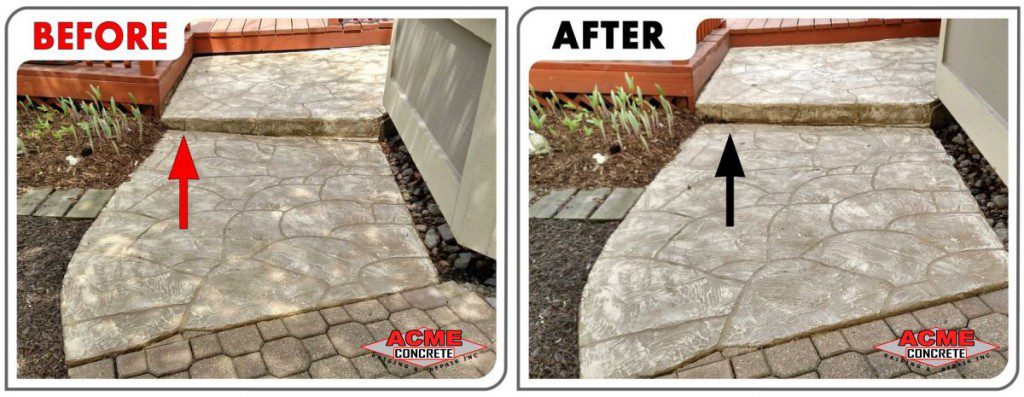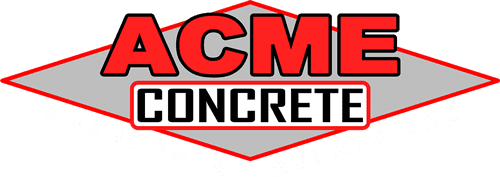A homeowner in Barrington, IL had stamped and stained concrete sidewalks and landings that began to sink due to erosion and animal activity under the slabs. This article explains how polyurethane injection restored the look, safety, and long-term stability of the decorative concrete.

Key Takeaways (Q&A)
What is the best way to raise stamped concrete in Barrington, IL?
Polyurethane injection is ideal for stamped and stained surfaces because it uses small ⅝″ holes and delivers precise, clean lifting with minimal surface impact.
How quickly can raised stamped concrete sidewalks in Barrington, IL be used?
Most residential slabs are ready for normal use within 15–30 minutes after polyurethane curing.
Will polyurethane foam help prevent future washout under stamped concrete in Barrington, IL?
Yes—polyurethane is water‑resistant, does not wash out, and helps fill and stabilize voids created by erosion.
Does Acme offer a warranty on polyurethane concrete raising in Barrington, IL?
Yes—residential concrete raising includes a 10‑year warranty on settlement beyond ½″.
Project Snapshot: Stamped Concrete Sidewalks & Landings
A Barrington homeowner invested in decorative, stone‑pattern stamped concrete. Over time, soil washed out and animals burrowed beneath two areas, leading to settlement, poor appearance, and uneven step transitions. Our crew assessed the voids, planned a precise injection layout, and selected the proper polyurethane to re‑establish support and lift the slabs back to grade.
Why Polyurethane Is Best for Stamped & Stained Surfaces
Stamped and stained concrete demands a repair method that respects the finish. Polyurethane lifting uses holes roughly the size of a dime (about ⅝″), which are patched neatly for a clean look—far smaller than traditional mudjacking holes. The material is lightweight (~4 lb/ft³), hydrophobic, and engineered to spread under the slab for uniform support, so the slab lifts smoothly without adding unnecessary weight to weak soils.
For an overview of the service, see Concrete Raising & Leveling | Acme Concrete Inc..
Step‑By‑Step: What We Did
Drill & Port – Strategically drilled small injection holes and installed ports to create sealed access under each slab.
Inject & Lift – Injected high‑performance polyurethane to fill voids and gently lift the slabs to the correct height and pitch.
Patch & Blend – Removed ports and patched holes with cement for a neat appearance that complements the stamped surface.
Final Check – Verified step heights, transitions, and drainage to ensure safe walking surfaces and proper water runoff.
Service Area: Barrington & Nearby Communities
Based in Crystal Lake, Acme serves communities throughout Chicagoland—including Barrington (60010). Crews regularly lift sidewalks, patios, stoops, driveways, and interior slabs for residential, commercial, and municipal clients in the area.
FAQs
Will drilling harm the stamped pattern or stain?
Polyurethane injection uses small, precisely placed holes (about ⅝″). Holes are patched with cement after lifting and blend cleanly into the surface. On decorative finishes, careful layout minimizes visibility while achieving the lift. Most customers find the tiny patches far less noticeable than the original settlement.
How does polyurethane compare to mudjacking for stamped concrete?
Mudjacking requires much larger holes and pumps in heavy, water‑based slurry that can shrink and add weight to already weak soils. Polyurethane uses tiny holes, cures in minutes, and is engineered to resist water and washout, making it the preferred option for decorative surfaces.
How long does the foam last under stamped sidewalks?
Cured polyurethane is permanent and water‑resistant. It remains stable through temperature swings and resists insects and microbial breakdown, providing long‑term support beneath the slab.
Do you serve my neighborhood in Barrington?
Yes. See our local page for details: Concrete Raising & Leveling Barrington IL | Acme Concrete. Estimates are free, and most residential projects require no deposit.
Should joints or cracks be sealed after the lift?
Yes. Sealing helps block water from entering through joints and cracks, protecting the subbase and extending the life of the repair. It also keeps debris from lodging in open gaps and reduces the chance of future movement around transitions and steps.
